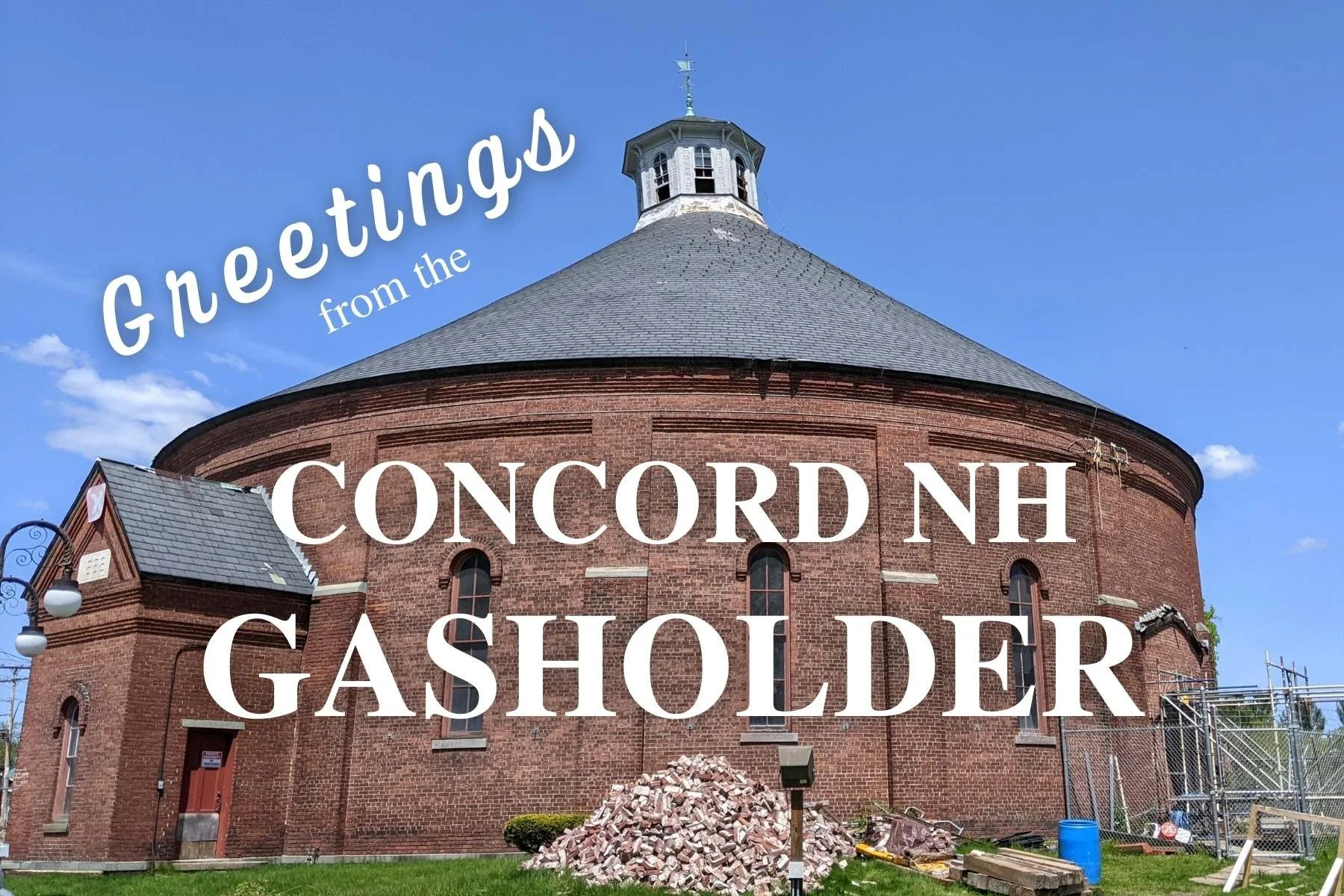Concord Gasholder Story Goes to the Arctic
International experts in revitalizing industrial sites invite the Concord Gasholder team to present the project’s story in northern Sweden.
Postcard of the Concord, NH Gasholder
Interest in the 1888 Concord Gasholder has been steadily growing through local and national events and news coverage. Now the Gasholder rehabilitation project will be featured at the international 19th TICCIH Congress in Kiruna, Sweden, a hundred miles north of the Arctic Circle. The week-long conference will highlight former gasworks and other international industrial sites that are being transformed into housing, public parks, tourist destinations and more.
TICCIH (The International Committee for the Conservation of the Industrial Heritage) is a worldwide organization. Its goals include international cooperation in preserving, investigating, interpreting, and advancing education of industrial heritage. The conference is titled “Heritage in action: Legacies of industry in future making.”
The Concord Gasholder project team was invited to present at the event because of the Gasholder’s status as the last of its kind with inner workings intact, the team’s successful community engagement efforts, and the development potential of the two-acre gasworks site.
New Hampshire Preservation Alliance team member Althea Barton is providing a virtual presentation for the conference. Other presenters include Dr. Barbara Berger, a Zurich, Switzerland-based architect and consultant for international conversion projects, including gasholders and water towers; Jouni Karki of the Suvilahti cultural center in Helsinki, Finland; and Evert Verhagen, presenting the Westergas cultural center of Amsterdam in the Netherlands.
Both Suvilahti and Westergas are vibrant cultural destinations centered around re-purposed gasholders and other historic industrial buildings. At Suvilahti, which is owned and operated by the city of Helsinki, a brick gasholder has been fully rehabilitated and a steel gasholder is being converted for cultural use. Tenants range from a brewery to a circus school. In Amsterdam, the re-purposed “Gashouder” is the icon of Westergas; it hosts up to 3,500 people for live shows, music festivals, theater and dining.
Decommissioned in 1952, the Concord Gasholder was listed on the National Register of Historic Places in 2018 thanks to the Concord Heritage Commission, and may well be worthy of even higher National Historic Landmark status. By 2020 it was on the verge of catastrophic collapse or demolition. Property owner Liberty, the City of Concord, and the N.H. Preservation Alliance have collaborated to put the Gasholder project on the road to success, with broad support from the community.
After nearly two years of intensive planning and complex engineering work, the structure is now stabilized and ready for further rehabilitation as an effective cap on contamination and a catalyst for neighborhood revitalization, connecting Concord’s industrial past with a new vision for the future.
The project partners are moving forward with a new phase of complex restoration work. Highly specialized engineers and contractors are developing plans to restore the round brick building and straighten its conical slate roof and tilted cupola, first damaged in the Hurricane of 1938. The team is working to identify ways to repurpose and revitalize the two-acre former gasworks property, including new opportunities for the public to engage with the site and its history.
TICClH is recognized by the International Council on Monuments and Sites (ICOMOS) as a designated consultant for the study and preservation of industrial heritage. lCOMOS is the global nongovernmental organization dedicated to conservation of the world’s historic monuments and sites. ICOMOS’s network of experts counsels UNESCO on historically significant industrial sites for the World Heritage List.
The 19th TICCIH Congress in Kiruna is organized by Luleå University of Technology, a leading university in the European Arctic, in collaboration with the TICCIH divisions in Sweden and Norway, the Swedish National Heritage Board, the municipality of Kiruna and a range of leading actors within industry and civil society in the Scandinavian north.
You can watch videos of the Kiruna conference on the TICCIH YouTube channel and visit the TICCIH 2025 Kiruna conference website. The Swedes love a good cup of coffee, often enjoying it with “chokladbollar” (chocolate balls). Try this recipe from Swedish chef Zeina Mourtada and pretend you’re in Kiruna!
Kiruna is a mining town in the Arctic Circle with a rich history. The area has been home to the Saami reindeer herders and Tornedalians for thousands of years. The Kiruna mine, which has been in operation since the 17th century, is the largest underground iron ore mine in the world, and has recently been a source of rare earth elements.
Several years ago, it was discovered that the historic buildings in the center of Kiruna were sinking into caverns excavated by decades of mining. Swedish state-owned mining company Luossavaara-Kiirunavaara Aktiebolag (LKAB) invested over a billion dollars to move about thirty historic structures to a new site about two miles east. New construction was added to create a new town center in the spirit of the original.
The Concord Gasholder team invites your comments and suggestions. Contact the New Hampshire Preservation Alliance at (603) 224-2281 or email projects@nhpreservation.org.


